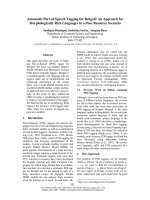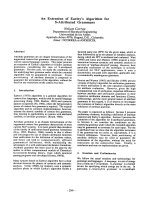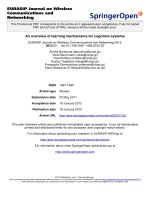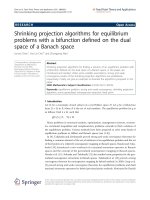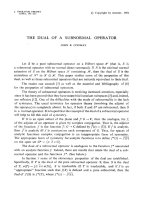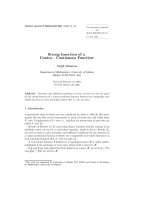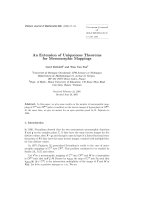Báo cáo toán học: "An extension of a criterion for unimodality" pps
Bạn đang xem bản rút gọn của tài liệu. Xem và tải ngay bản đầy đủ của tài liệu tại đây (81.64 KB, 7 trang )
An extension of a criterion for unimodality
Jenny Alvarez
Department of Mathematics
UC Santa Barbara, CA, USA
Miguel Amadis
Department of Mathematics
Nyack College, New York, NY, USA
George Boros
Department of Mathematics
Xavier University, New Orleans , LA 70125 USA
Dagan Karp
Department of Mathematics
Tulane University, New Orleans, LA 70118 USA
Victor H. Moll
Department of Mathematics
Tulane University, New Orleans, LA 70118 USA
Leobardo Rosales
Department of Mathematics
UC San Diego, CA USA
Submitted: March 20, 2001; Accepted: September 19, 2001.
Subject Classifications: 40, 33, 05
Abstract
We prove that if P (x) is a polynomial with nonnegative nondecreasing coeffi-
cients and n is a positive integer, then P (x +n) is unimodal. Applications and open
problems are presented.
1 Introduction
A finite sequence of real numbers {d
0
,d
1
, ···,d
m
} is said to be unimodal if there exists an
index 0 ≤ m
∗
≤ m, called the mode of the sequence, such that d
j
increases up to j = m
∗
and decreases from then on, that is, d
0
≤ d
1
≤ ··· ≤ d
m
∗
and d
m
∗
≥ d
m
∗
+1
≥ ··· ≥ d
m
.
A polynomial is said to be unimodal if its sequence of coefficients is unimodal.
the electronic journal of combinatorics 8 (2001), #R30 1
Unimodal polynomials arise often in combinatorics, geometry and algebra. The reader
is referred to [3] and [4] for surveys of the diverse techniques employed to prove that spe-
cific families of polynomials are unimodal.
A sequence of positive real numbers {d
0
,d
1
, ···,d
m
} is said to be logarithmic concave
(or log concave for short) if d
j+1
d
j−1
≤ d
2
j
for 1 ≤ j ≤ m − 1. It is easy to see that if a
sequence is log concave then it is unimodal [5]. A sufficient condition for log concavity
of a polynomial is given by the location of its zeros: if all the zeros of a polynomial are
real and negative, then it is log concave and therefore unimodal [5]. A simple criterion
for unimodality was established in [2]: if a
j
is a nondecreasing sequence of positive real
numbers, then
P (x +1) =
m
j=0
a
j
(x +1)
j
(1)
=
m
j=0
d
j
(m)x
j
(2)
is unimodal. This criterion is reminiscent of Brenti’s criterion for log concavity [3]. A
sequence of real numbers is said to have no internal zeros if d
i
,d
k
=0andi<j<kimply
d
j
= 0. Brenti’s criterion states that if P (x) is a log concave polynomial with nonnegative
coefficients and with no internal zeros, then P (x + 1) is log concave.
In this paper we first prove that under the same conditions of [2] the polynomial
P (x + n) is unimodal for any n ∈
, the set of positive integers. We also characterize the
unimodal sequences {d
j
} that appear in [2] and discuss the behavior of the coefficients
of P (x + 1) for a unimodal polynomial P(x). Numerical evidence suggests that the
unimodality result is true for n real and positive. This remains to be investigated.
2 The extension
In this section we prove an extension of the main result in [2]. We start by establishing
an elementary inequality.
Lemma 2.1 Let m, n ∈
and m
∗
:=
m
n+1
. Then (n +1)m
∗
≤ m ≤ (n +1)m
∗
+ n.
Proof This follows directly from
m
n+1
− 1 <m
∗
≤
m
n+1
.
Theorem 2.2 Let 0 ≤ a
0
≤ a
1
··· ≤ a
m
be a sequence of real numbers and n ∈ , and
consider the polynomial
P (x)=a
0
+ a
1
x + a
2
x
2
+ ···+ a
m
x
m
. (1)
Then the polynomial P (x + n) is unimodal with mode m
∗
=
m
n+1
.
the electronic journal of combinatorics 8 (2001), #R30 2
We now restate Theorem 2.2 in terms of the coefficients of P .
Theorem 2.3 Let 0 ≤ a
0
≤ a
1
···≤a
m
be a sequence of real numbers and n ∈ . Then
the sequence
q
j
:= q
j
(m, n)=
m
k=j
a
k
k
j
n
k−j
(2)
is unimodal with mode m
∗
=
m
n+1
.
Proof The coefficients q
j
(m) in (2) are given by
q
j
(m)=
m
k=j
a
k
k
j
n
k−j
(3)
so that Theorem 2.3 follows from Theorem 2.2. Now
(i +1)(q
i+1
(m) − q
i
(m)) ≤
m
k=i
a
k
k
i
n
k−i−1
[k − (n +1)i − n] . (4)
Suppose m
∗
≤ i ≤ m − 1. Then
k − (n +1)i − n ≤ m − (n +1)i − n ≤ m − (n +1)m
∗
− n ≤ 0, (5)
where we have employed the Lemma in the last step. We conclude that every term in the
sum (4) is nonpositive. Thus for m
∗
≤ i ≤ m − 1wehaveq
i+1
(m) ≤ q
i
(m).
Now assume 0 ≤ i ≤ m
∗
− 1. We show that q
i+1
(m) ≥ q
i
(m). Observe that in this
case the sum (4) contains terms of both signs, so the positivity of the sum is not apriori
clear. Consider
(i +1)(q
i+1
(m) − q
i
(m)) =
m
k=(n+1)i+n+1
a
k
k
i
n
k−i−1
[k − (n +1)i − n]
−
(n+1)i+n−1
k=i
a
k
k
i
n
k−i−1
[−k +(n +1)i + n]
:= T
2
− T
1
. (6)
Observe that
T
1
=
(n+1)i+n−1
k=i
a
k
k
i
n
k−i−1
[−k +(n +1)i + n]
≤ a
(n+1)(i+1)
(n+1)i+n−1
k=i
k
i
n
(n+1)i+n−1−i−1
[−k +(n +1)i + n]
≤ a
(n+1)(i+1)
n
(i+1)n−2
(n+1)i+n−1
k=i
k
i
[−k +(n +1)i + n] .
the electronic journal of combinatorics 8 (2001), #R30 3
The monotonicity of the coefficients of P was used in the first step.
The last sum can be evaluated (e.g. symbolically) as
(n+1)i+n−1
k=i
k
i
[−k +(n +1)i + n]=
((n +1)i + n +1)!
(i +2)!(ni + n − 1)!
,
so that
T
1
≤ a
(n+1)(i+1)
n
(i+1)n
×
((n +1)i + n +1)!
n
2
(i +2)!(ni + n − 1)!
≤ a
(n+1)(i+1)
n
(i+1)n
×
((n +1)i + n +1)!
(ni +2n)(ni + n) i!(ni + n − 1)!
.
Now observe that
((n +1)i + n +1)!
(ni +2n)(ni + n) i!(ni + n − 1)!
≤
(n +1)(i +1)
i
.
The inequality T
1
≤ T
2
now follows since the upper bound for T
1
established above is the
first term in the sum defining T
2
.
Corollary 2.4 Let 0 ≤ a
0
≤ a
1
···≤a
m
be a sequence of real numbers, n ∈ , and
P (x)=a
0
+ a
1
x + a
2
x
2
+ ···+ a
m
x
m
.
Then P (x + n) has decreasing coefficients for n ≥ m.
Example 2.5 Let 2 <a
1
< ···<a
p
and r
1
, ···,r
p
be two sequences of positive integers.
Then the sequence
q
j
:=
m
k=j
n
k−j
a
1
m
k
r
1
a
2
m
k
r
2
···
a
p
m
k
r
p
k
j
, 0 ≤ j ≤ m
is unimodal.
3 The converse of the original criterion
The original criterion for unimodality states that if P (x) has positive nondecreasing coeffi-
cients, then P (x+1) is unimodal. In this section we discuss the following inverse question:
Given a unimodal sequence {d
j
:0≤ j ≤ m}, is there a polynomial P (x)=a
0
+ a
1
x +
···+ a
m
x
m
with nonnegative nondecreasing coefficients such that
P (x +1) =
m
j=0
d
j
x
j
(1)
the electronic journal of combinatorics 8 (2001), #R30 4
We begin by expressing the conditions on { a
j
} that guaranteed unimodality of P (x+1)
in terms of the coefficients {d
j
}. Recall that
d
j
=
m
k=j
a
k
k
j
(2)
and
a
j
=
m
k=j
(−1)
k−j
d
k
k
j
. (3)
Lemma 3.1 Let 0 ≤ j ≤ m. Then
a
j
≥ 0 ⇐⇒ d
j
≥
m
k=j+1
(−1)
k−j+1
d
k
k
j
. (4)
Proof This follows directly from (3).
Lemma 3.2 Let 0 ≤ j ≤ m − 1. Then
a
j
≤ a
j+1
⇐⇒ d
j
≤
m
k=j+1
(−1)
k−j+1
d
k
k +1
j +1
.
Proof This follows directly from the identity
a
j+1
− a
j
=
m
k=j+1
(−1)
k−j+1
d
k
k +1
j +1
− d
j
.
We now combine the previous two lemmas to produce a criterion for unimodality.
Theorem 3.3 Let Q(x)=d
0
+ d
1
x + ···+ d
m
x
m
and assume the coefficients {d
j
} satisfy
the inequalities
m
k=j+1
(−1)
k−j+1
d
k
k
j
≤ d
j
≤
m
k=j+1
(−1)
k−j+1
d
k
k +1
j +1
. (5)
Then Q(x) is a unimodal polynomial for which P (x):=Q(x − 1) has positive and non-
decreasing coefficients. Furthermore, for any n ∈
, Q(x + n) is unimodal with mode
m
n+2
.
Proof The first part follows from the previous two lemmas. For the second part, Theo-
rem 3.3 shows that Q(x − 1) has nonnegative, nondecreasing coefficients, so Theorem 2.2
yields the result.
the electronic journal of combinatorics 8 (2001), #R30 5
Note. The inequality (5) is always consistent. The difference between the upper and
lower bound is
m
k=j+1
(−1)
k−j+1
d
k
k +1
j +1
−
m
k=j+1
(−1)
k−j+1
d
k
k
j
=
m
k=j+1
(−1)
k−j+1
d
k
k
j +1
= a
j+1
,
so the difference is always nonnegative.
Note. It would be interesting to describe the precise range of the map (a
0
,a
1
, ···,a
m
) →
(d
0
,d
1
, ···,d
m
). This map is linear, so the image of the set 0 ≤ a
0
≤ ··· ≤ a
m
is a
polyhedral cone. In this paper we state one simple restriction on this image.
Proposition 3.4 Let a
j
≥ 0. Then d
j
≥ d
j+1
for j ≥m/2.
Proof This follows directly from
d
j
− d
j+1
=
m
k=j
a
k
k
j
−
m
k=j+1
a
k
k
j +1
= a
j
+
m
k=j+1
a
k
k!(2j +1− k)
(j +1)!(k − j)!
since every term in the last sum is nonnegative.
4 A criterion for log concavity
Any nonnegative differentiable function f that satisfies f (0) = f(m)=0andf
(x) ≤ 0
yields the unimodal sequence {f (j):0≤ j ≤ m}. The next theorem shows that these
sequences are always log concave.
Proposition 4.1 Let P (x)=
m
k=0
c
k
x
k
be a unimodal polynomial with mode n. Assume
in addition that c
j+1
− 2c
j
+ c
j−1
≤ 0. Then P (x) is log concave.
Proof Let j<n,sothatc
j
≥ c
j−1
. The condition on c
j
can be written as c
j
− c
j−1
≥
c
j+1
− c
j
,sothat
c
j
c
j
− c
j
c
j−1
≥ c
j+1
c
j−1
− c
j
c
j−1
,
and thus the log concavity condition holds. The case j ≥ n is similar.
the electronic journal of combinatorics 8 (2001), #R30 6
5 The motivating example
The original criterion for unimodality in [2] was developed in our study of the coefficients
d
l
(m) of the polynomial
P
m
(a)=
1
π
2
m+3/2
(a +1)
m+1/2
∞
0
dx
(x
4
+2ax
2
+1)
m+1
(1)
considered in [1]. These coefficients are given explicitly by
d
l
(m)=2
−2m
m
k=l
2
k
2m − 2k
m − k
m + k
m
k
l
, (2)
and we have conjectured that {d
l
(m)}
m
l=0
forms a log concave sequence. Unfortunately
Proposition 4.1 does not settle this question. For example, for m = 15 the sequence of
signs in d
j+1
(15) − 2d
j
(15) + d
j−1
(15), for 1 ≤ j ≤ 14, is
sign(15) = {+1, +1, +1, +1, +1, −1, −1, −1, −1, +1, +1, +1, +1, +1},
so the condition fails.
6 Acknowledgements
The work presented here was part of a SIMU project at the University of Puerto Rico
at Humacao. The authors wish to thank Herbert Medina and Ivelisse Rubio for bringing
them together. The fifth author acknowledges the partial support of NSF-DMS 0070567,
Project number 540623.
References
[1] Boros, G. - Moll, V.: An integral hidden in Gradshteyn and Rhyzik.Jour.Comp.
Appl. Math. 237, 272-287, 1999.
[2] Boros, G. - Moll, V.: A criterion for unimodality.Elec.Jour.Comb.6, # R10, 1999.
[3] Brenti, F.: Log-concave and unimodal sequences in Algebra, Combinatorics and Ge-
ometry: an update. Contemporary Mathematics, 178, 71-84, 1994.
[4] Stanley, R.: Log-concave and unimodal sequences in algebra, combinatorics and ge-
ometry. Graph theory and its applications: East and West (Jinan, 1986), 500-535,
Ann. New York Acad. Sci., 576, New York, 1989.
[5] Wilf, H.S.: generatingfunctionology. Academic Press, 1990.
the electronic journal of combinatorics 8 (2001), #R30 7
